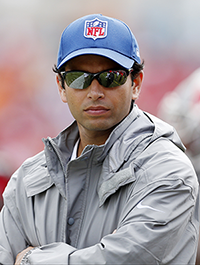
The first rule of being a doctor for a professional sports team: You do not talk about the team. To be more precise, you do not talk about the athletes you treat on the team. The wrong word about a player’s health could hurt far more than any sprain, strain, or break. This is something Sanjay Menon, M.D. ’06, learned quickly as he began his career in sports medicine.
“Athletes are very sensitive about how their stories and interactions are portrayed … there’s suspicion about team doctors,” says the 36-year-old son of Indian immigrants. Based at Suncoast Medical Clinic in St. Petersburg, Florida, Menon is the team physician for the National Football League’s Tampa Bay Buccaneers and an orthopedic consultant to Major League Baseball’s Tampa Bay Rays and the North American Soccer League’s Tampa Bay Rowdies. “I want any athlete I work with to know I work for them and not anybody else.”
As a cautionary tale, he cited the example of a well-known sports medicine surgeon who was incompletely quoted about a surgery performed on a star college quarterback. The player’s NFL draft value plummeted and the player never forgave his doctor.
“If athletes know I have their best interests in mind professionally, they will be confident that I’m watching out for them medically, too,” Menon explains. In the high-stakes world of professional sports, being a skilled physician, like being a gifted athlete, is not enough.
Though he’s the son of a successful orthopedic hand surgeon who designed the modern-day wrist replacement, Menon initially tried a different career tack. A music and humanities major at the University of Southern California, Menon sang in a rock band and worked as a trainee talent agent for the Endeavor agency, headed by Ari Emanuel, who was immortalized in the fictional TV series “Entourage.” “One of the greatest skills you learn in that business is communication,” explains Menon. “Physicians are often faulted for not communicating well.”
Ultimately, medicine lured him back, and Menon enrolled in a post-baccalaureate, premedical program at Scripps College in Claremont, California, where his high achievement ensured an interview at GW’s School of Medicine and Health Sciences (SMHS). That brought him east to Foggy Bottom and a literal love affair at SMHS. He met his wife, Amy Strickland, M.D. ’06, at med school, and before long their classmates made up nearly a third of their wedding guest list. Strickland is now the gastroenterologist for the Tampa Bay Rays, so whether it’s your bones or your belly that is aching, the Strickland-Menon family has you covered, they joke.
“I’ve always felt I was extremely well prepared by the teachers at SMHS,” Menon says with pride. “That helped me get into a good residency program at Los Angeles County Harbor–UCLA Medical Center.” The springboard into sports medicine was a prestigious one-year orthopedic fellowship with the legendary James Andrews, M.D., one of the most innovative sports surgeons in the world. Andrews mentors dozens of jock docs, including Menon.
Menon’s 2011–12 fellowship took him to the Andrews Institute in Gulf Breeze, Florida, which features a high-level sports fitness facility where many elite athletes rehab or train. He got his first college exposure during that period as a team physician for Auburn University. Studying at Andrews put Menon “on the radar” with pro teams, as did working with elite high school football teams and having a connection with a former Andrews fellow working with the Tampa Bay Rays.
“So by taking care of athletes and being available, [you encourage] people [to] think of you when positions open,” says Menon.
Menon is busy on and off the playing field, regularly seeing patients at the Suncoast clinic. “When it comes to an injury, you treat everyone the same,” he explains. “One of my mentors would say, ‘Don’t get fancy.’ With athletes, however, the timeline [for repair and recovery] may get compressed. For an athlete there may be less of a role for conservative care, depending on the injury and the remaining schedule.”
Sports medicine requires Menon to stay up to date with innovative therapies, particularly the use of biologics such as stem cells and PRP (platelet-rich plasma) — treatments that can speed healing. Injury types vary with each sport, however. Football players suffer more acute injuries, such as ligament tears and dislocations, whereas baseball produces more chronic overuse injuries from early specialization in a single sport. Baseball is rife with cases of the so-called Tommy John surgery for pitchers who have worn out or torn the ulnar collateral ligament in their elbows. Among soccer players, Menon sees both overuse and acute injuries.
The resiliency and determination of athletes continues to impress Menon. He cites the example of a Rays pitcher who underwent Tommy John surgery a year ago. While participating in the extensive rehab, and essentially putting his life and career on hold for more than a year, the pitcher suffered a major setback during a throwing session when his medial epicondyle tore off. Another surgery with a lengthy rehab was required.
“What was so remarkable was how composed and deliberate the player was about the whole event,” Menon recalls. “The hallmark of a true professional competitor is seeing each challenge as just part of the game. He told me he was ready to get the procedure done so he could get back to where he needed to be.”
Menon’s job is to get players back on the field — not to talk about it. He admires his patients. “The best thing about working with athletes is their drive and their love of sports,” he says.